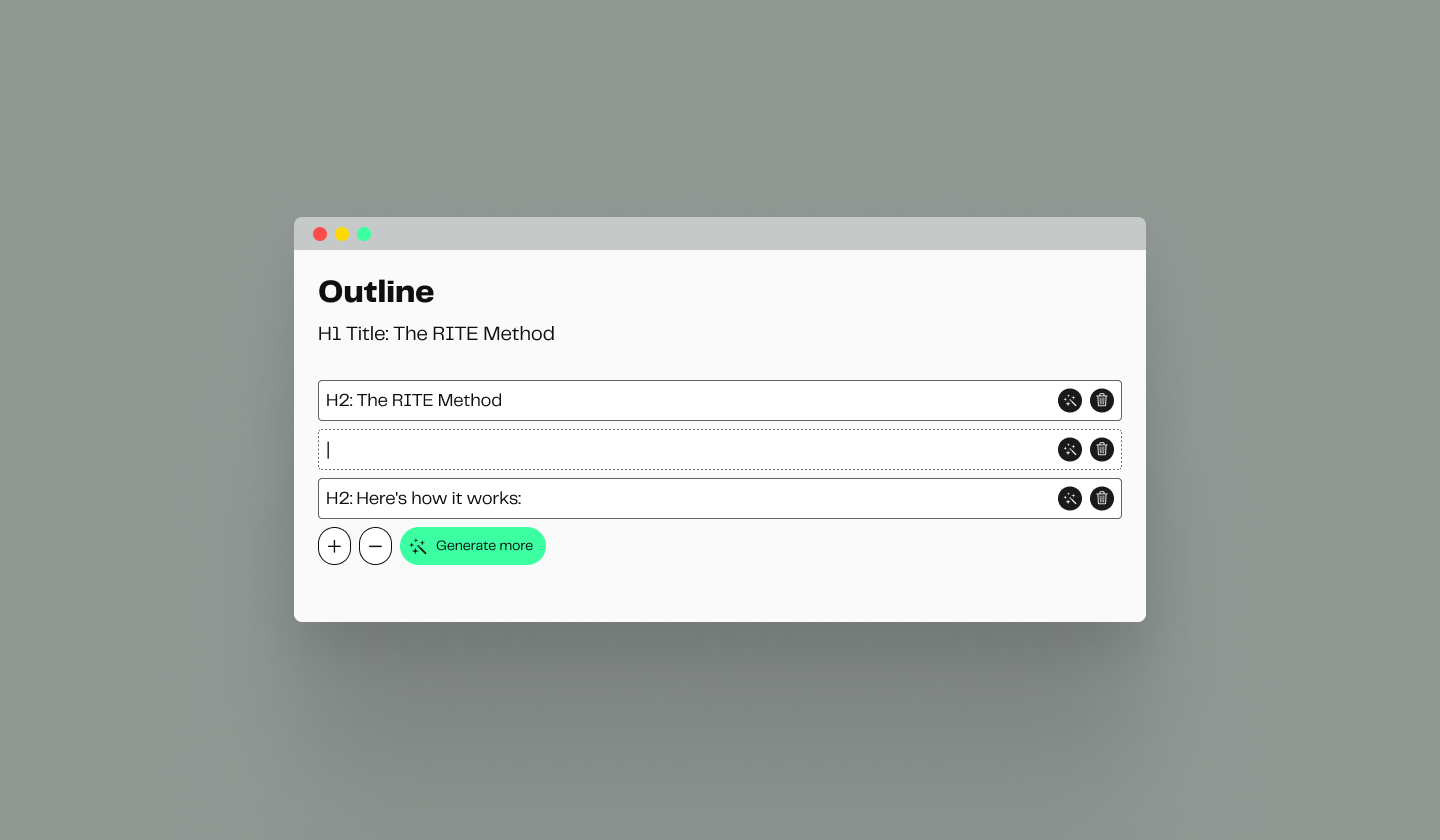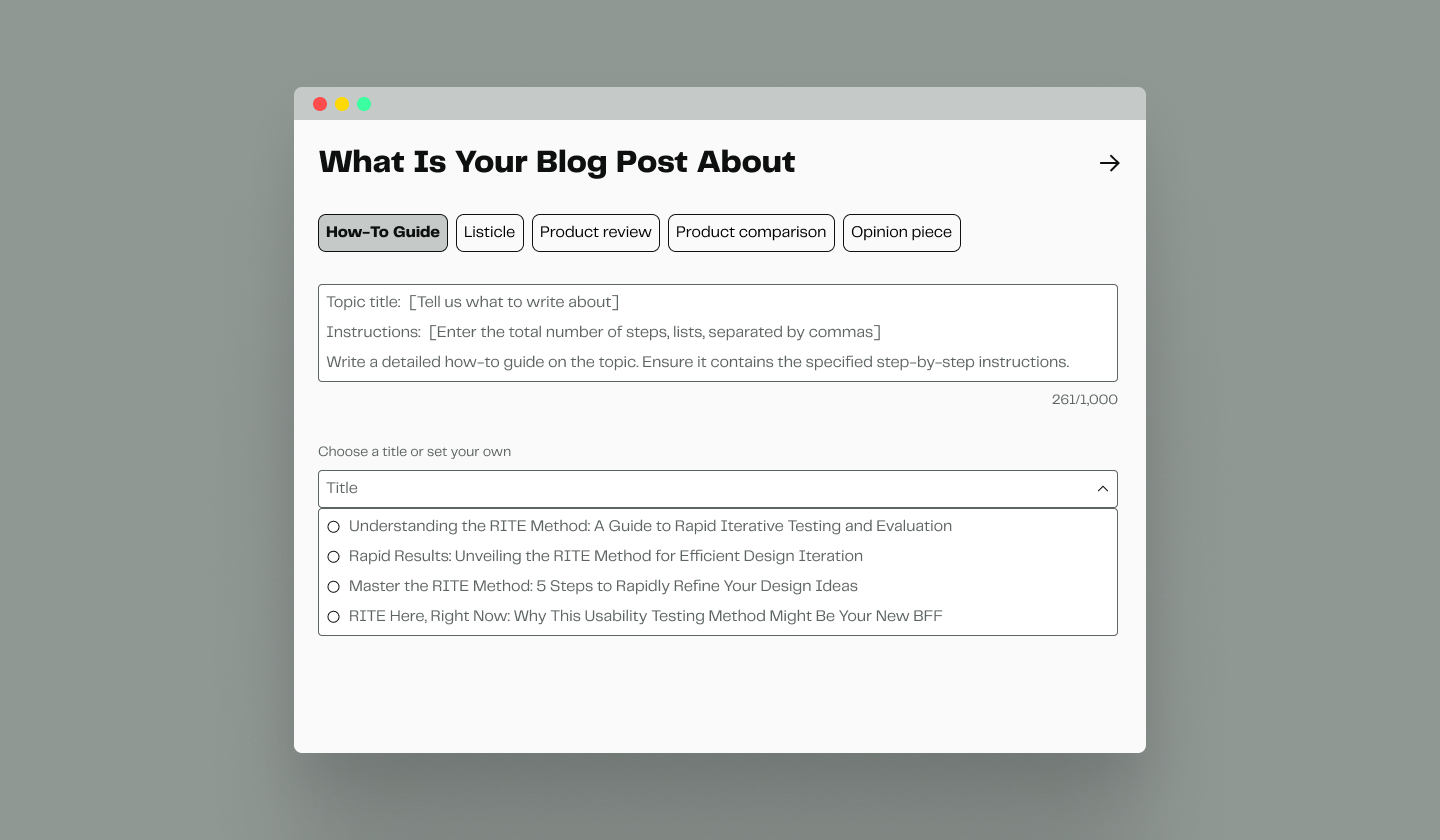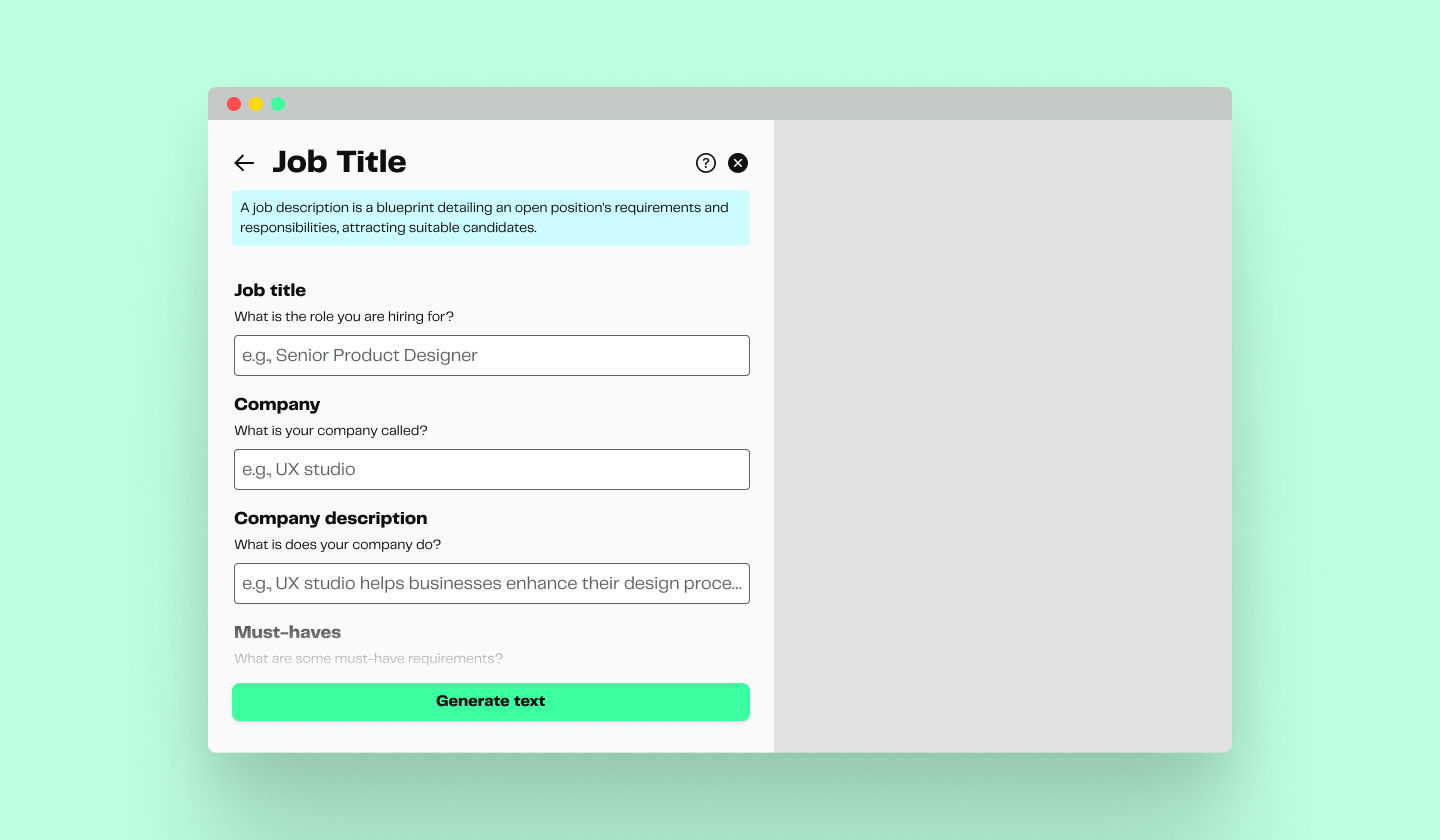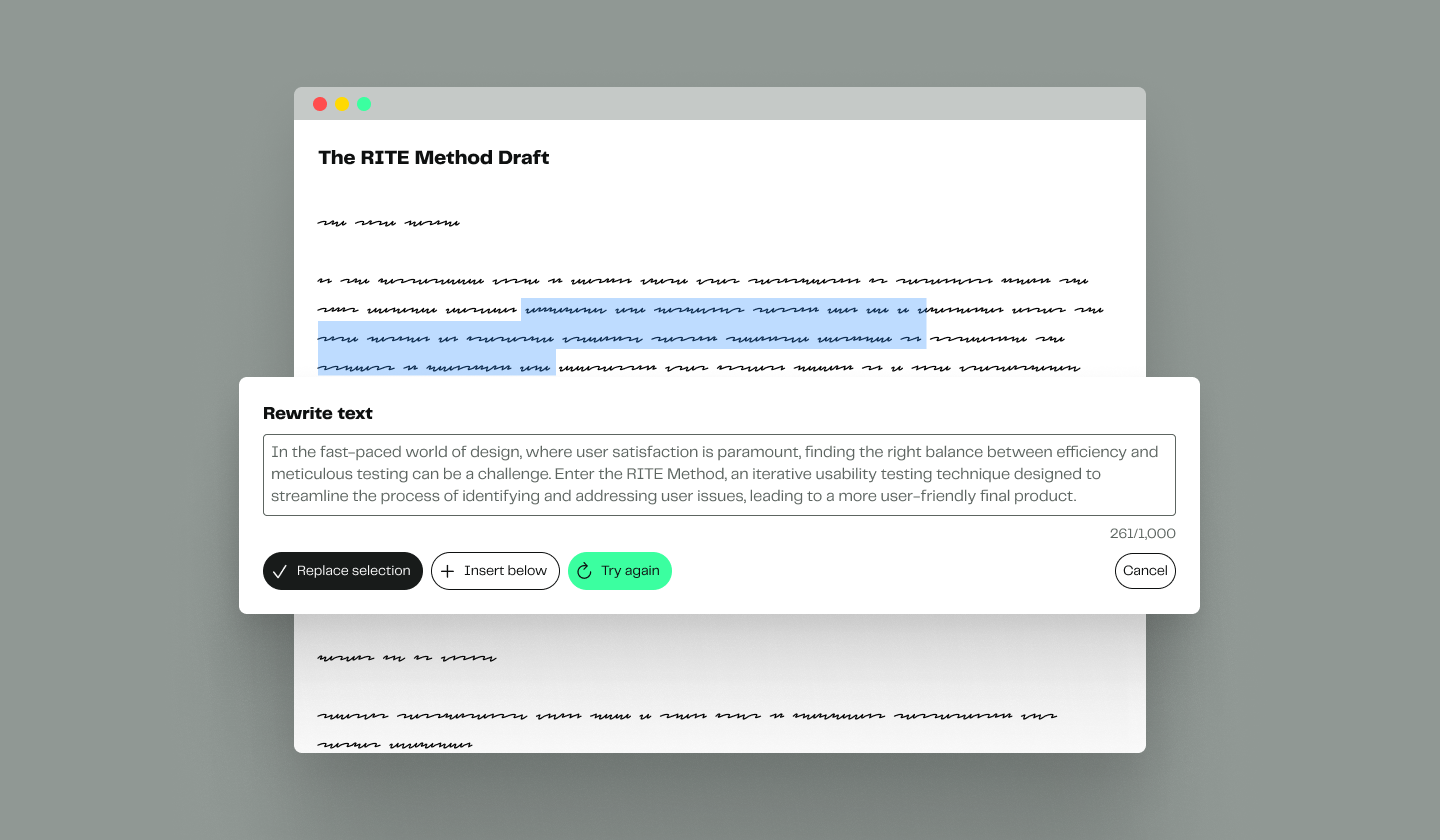With the rise of readily available generative AI tools, it is now possible to create large bodies of text in a matter of seconds. However, crafting the right prompts to achieve the desired output can be challenging. In this article, we will examine the complexities of prompting and how AI writing tools can simplify the process. We will share our experience with AI writing tools that help users generate high-quality content by creating complex prompts in the background. Also, we’ll provide our likes and dislikes of the UX solutions used in these tools.
Prompting Issues in Generative AI
As generative AI becomes increasingly accessible. More and more people want to utilize its capabilities. However, the success of harnessing the full potential of generative AI depends on the user’s ability to craft effective prompts. Providing instructions to an AI tool may appear to be easy, but it is often more complex than it seems.
An Everyday Example of Prompting Difficulties
Suppose you are not an experienced user of these tools. In that case, you have probably faced this problem before and can relate to the following scenario. You decide to write a blog post on a specific topic and turn to ChatGPT to help with the writing, ultimately saving a significant amount of time.
You type in a simple prompt, such as “Write a blog post about the RITE method.” Since you have prior knowledge of the subject, you already have some ideas about what the blog post should cover. Therefore, you are disappointed that the generated text does not align with your expectations. The possible issues of an output generated using a short and simple prompt are the following:
- It is not suitable for length, either too short or too long.
- The use of language is too complicated.
- It misses the relevant sub-topics you wanted to address.
At this point, you may add extra prompts, sometimes individually, hoping to reach the desired outcome. However, the result can become increasingly chaotic.
In conclusion, if you cannot convey your requests clearly, the AI may not be able to produce the desired outcome. This might cause you frustration or confusion.
The Articulation Barrier
You are not the only one to face challenges while prompting. In fact, there is a term specifically used to describe this challenge: Articulation barrier. You may imagine it as a roadblock in effective communication between the user’s intention and the AI’s execution. For successful communication with AI, people need to convey their thoughts in a way that the AI can understand and interpret correctly. Without a deep understanding of generative AI tools’ abilities and limitations, this can be difficult.
In addition to individuals’ different levels of understanding of how AI processes prompts, the articulation barrier has another element. People’s varying ability to express themselves, regardless of whether the conversation partner is AI or another human being. If an individual has challenges expressing themselves properly while interacting with other people, communication with AI where common understanding or nonverbal cues can’t help, is certainly going to be more difficult.
There are many articles on this topic already, so we won’t go into more detail now. However, if you want to read more about it, you should start by checking out Jakob Nielsen’s summary of the topic.
How AI-Powered Writing Tools Simplify Prompting
If you require assistance writing lengthy texts, going to ChatGPT is not your only option. An abundance of writing assistants powered by AI attempt to simplify the process, mainly by helping users with prompting. Rather than directly interacting with a model such as ChatGPT, these writing assistants create a bridge between the users and the generative AI tools. To do so, they create a sequence of behind-the-scenes prompts based on information they gather from the users. Once all necessary information is gathered and often reviewed by the user, the AI writing assistants feed the prompt to the generative AI tools they use in the background. This may be ChatGPT or any other tool – to create big bodies of copy.
These tools present us with a user-friendly interface. Sometimes with some personalized settings for writing style preferences. Blog posts are probably the most popular content type these tools are used to create, however, these tools are not limited to blog posts as outputs. You can use them to generate any long or short copy. These include job descriptions, landing page copies, product descriptions, case studies, or FAQ sections. The list can go on as long as you can think of an additional type of copy you’d ever have to write.
After selecting the desired content type, the tools ask for specific information through simple input fields. So, instead of asking ChatGPT to create a blog post about a specific topic by creating a long prompt that includes your predetermined talking points, preferred tone of voice, desired length, and so on, the input fields guide you and do the thinking for you. Once you add all the information, they create a sophisticated prompt in the background, and you receive the output.
If you give all the information – and choose a tool that actually asks for the right information – you can receive surprisingly quality results. And this is the tricky part. Generative AI has been widely accessible for a relatively short time. Yet, the number of new AI-powered writing assistant tools is enormous. With such a huge number of new tools, it can be challenging to find the right one.
Navigating the Ups and Downs of AI Writing Tools
As previously stated, the effectiveness of a tool and its ability to create output that meets high standards can vary depending on which one we use. The best AI writing tools pleasantly surprised us with the high quality of their work. Yet, we would often only be able to use the output in our professional setting after giving it a lot of extra attention by reviewing and editing the copy. To learn more about AI and UX writing, check out our article on this topic.
Aside from the quality of the output, other factors influence our perception of these tools. As a UX agency, we always look at the usability of products we come across even if it is not a project we are working on. While trying out these AI writing tools we came across some that provided excellent user experience and some that caused some unease. And bad user experience is usually correlated with lower-quality output in the case of these AI-powered writing assistants.
We are not here to list the best AI writing tools. Even though we had our preferences when trying them, a lot more time and testing would be needed. Also, we’d need a proper evaluation of the SEO and other marketing-related claims these tools make.
At the same time, we found some UX solutions that we liked, but some left us unsatisfied. We collected these good and not-so-good practices. Yet, we are not giving definite evaluations of these AI-powered writing assistants. For this reason, instead of sharing screenshots of actual tools, we created example illustrations of the UX solutions we’ll discuss. If you’re interested in our evaluation of AI tools, check out our article on the best AI tools for design and research. You can also read a more in-depth guide to AI tools for research.
AI writing tools’ steps for gathering data
When you start creating a large body of text using an AI writing tool, your first interaction will be with a content builder. These builders try to get as much information from the user as needed to create an output they deem sufficient. As with any digital product, there are some great solutions to be found, and some that can affect the users’ experience negatively.
Let’s start with a good example.
We were fond of tools that guided us step by step. They gradually asked for additional information and feedback before producing the final product. When creating a blog post, these tools would start by asking for some or all of the essentials. These include the topic, sometimes the specific type of blog post to create, and information on keywords and target audience. As the next step, they present a proposed outline.

The above solution created a logical structure for our topic while allowing us to insert, rearrange, or completely recreate points in the outline. This is a good solution, as these tools acknowledge that they cannot read minds. Therefore, they offer users considerable flexibility and control so they can make changes before the final output is created. At the same time, these recommendations benefit those who don’t have a clear outline in their mind yet.
On the other side
As opposed to this solution, which had good usability, we encountered tools that were quite painful to interact with.
Sticking to blog post outlines as an example, we came across tools that failed to impress us with their suggestions. They, probably unintentionally, hid the option for adding more topics.
Our most memorable negative experience was an outline generator. It, in addition to creating an illogical order of subtopics, didn’t allow us to rearrange them by dragging and dropping. While it was possible to manually copy, delete, and paste topics, the entire process became too complicated and frustrating.

The subtopics presented by this tool after clicking “Generate more” were not satisfying for us either. They often continued an illogical structure and were sometimes quite difficult to understand. Even though we have seen significantly better suggestions, this tool at least made an effort to provide us with some guidance.
One of the AI writing tools we tried only gave us a text box with minimal instructions. After using a tool that was very helpful and came up with nice outlines, this felt extremely disappointing. Additionally, the blog post types felt limiting. The topic we were using to test these tools – the RITE method – didn’t particularly align with any of the available choices.

Despite its shortcomings, this tool did offer some title suggestions. Still, it didn’t help our initial disappointment of making us do much more thinking than more sophisticated solutions.
The key takeaway
Overall, we found that regardless of the content type we wanted the AI to create for us, the best experience and the best outputs came from tools that asked numerous relevant questions without being overwhelming.
Using AI for creating long pieces, such as blog posts, may require more attention from the human writer. On the other hand, other content types can be much easier to create. One of our biggest pleasant surprises was a job post one of the tools generated after asking a few right questions.

The usability of text editors within AI writing tools
Once you have gone through the steps of providing information to the AI tool to generate your copy, you can proceed to review and revise the text. While most tools claim to offer excellent assistance while editing the text, our experience is that only a few of the ones we tried were outstanding in this regard.
The tool that impressed us the most
The tool that impressed us the most provided a lot of flexibility and control while giving ample guidance.
What stood out the most was its ability to generate various new versions of rewriting a specific section. Once we select our preferred method of rephrasing – such as simplifying or refining for more elevated language, making it more professional or casual, and so on – the tool comes up with several options. Highlighting the changes in the suggested versions adds a lot to the user experience here. This small yet significant feature helps enormously in comparing the new versions to the original one. This makes it easier to choose the one that fits our needs the most.
Individuals who work with large amounts of written content are likely to be familiar with Grammarly. Probably building on this, the tool borrowed the solution of displaying the different types of improvements it offers on the right side of the screen for convenient access to these sections.

On the other side
As opposed to this, some tools put less effort into their text editors. As previously mentioned, once you experience using highly effective and user-friendly tools, you can easily feel let down by the less sophisticated ones. This may be the case here too: only providing one version for rewriting with no aids to scan the changes feels like an overly simple solution for an AI-powered writing tool.

The example above also had frustrating usability issues. For example, if you wanted a different way or style of rewriting, you would have to go back to the text, highlight the chosen part and ask the editor to rephrase it again. While not catastrophic, these types of usability annoyances can greatly impact the success of a product.
Why is it important to examine the small features of these complex AI writing tools?
An AI-powered assistant may generate the best copy. If the users get frustrated along the way or misunderstand functionalities, they may look for other solutions. The examples we collected above may seem like small things; some may believe they could make or break a product. However, it is important to consider why people reach for these products. First, they need guidance creating the prompts. They possibly want options to choose from and probably want the freedom to change the output. During that, they are getting noticeably more from the tools than if they were simply using the combination of a document creator and ChatGPT.
The above examples show how features of these tools can help users reach their goals.
- They give complex solutions with well thought out steps of asking for information.
- They also provide user-friendly input fields and extra steps of including the user in the creation process.
- They give them the option to easily make changes along the way.
In contrast, some tools provide the illusion of guidance. However, users soon realize that they require a lot of extra effort and thinking along the way to create a sound output. In some extreme cases, some of which are highlighted above, silly usability issues block users from effectively using the product.
A lot is going on behind the surface for these tools. While the focus may be on creating complex prompts, the creators of digital products should always think of the end users. This is why usability testing is crucial to detect usability issues and fixing them before they cause frustration or even obstruct the proper functioning of a product. If these issues are not addressed, users can quickly move to another product in the hopes of finding better solutions and never looking back.
Can AI Writing Tools Teach Us to Prompt Better?
As a UX researcher, I am not an expert on generative AI and prompting, so I won’t be able to guide you on how to prompt like a pro. However, after testing these tools, evaluating their usability, and seeing the connection between good usability and high-quality output, I started to get a lot deeper understanding of how a good prompt may work.
I used to be like the example I shared above. I treated AI a bit like a mind reader instead of realizing that it needs to understand every single little detail about what I would like to receive if I wanted a satisfactory outcome.
To test my new skills, I went to ChatGPT recently, and instead of one or two short sentences, I created a very long prompt. I used my learnings of testing the AI writing tools and made sure to do the following:
- Specify the blog post type.
- Add details about the tone of voice.
- Give an outline to make sure the output follows the right talking points (generative AI can help with the brainstorming here too).
- On top of the outline, highlight specific elements to include or not to include.
- Determine the length.
- Add information about where it will be used and who the audience will be.
The outcome was exceptional. It was probably the best AI-generated blog post I read over these days of exploring these writing tools.
In conclusion, yes, these AI writing platforms did teach me to prompt better. Using them for a few different assignments, seeing what and how much input gave satisfactory results and what type of input-gathering method resulted in less adequate output served as good guidelines when making my own prompt from scratch. I’m still not a pro, but definitely getting better at it!
Final Thoughts
In conclusion, AI writing tools could transform how we generate large bodies of text through generative AI. They act as intermediaries, simplifying the prompting process and bridging the articulation barrier.
It is important to note that the quality and usability of AI writing tools can vary. While some tools produce impressive results, others require significant editing and refinement. Furthermore, even if a tool can technically create sound output, if its usability is overlooked, it can significantly impact user satisfaction and overall product success. Good UX practices, such as step-by-step guidance, flexible outline generators, and user-friendly text editors, with multiple rewriting options, can greatly enhance the user experience and users’ likelihood of sticking with a product.
An unexpected benefit of using AI writing tools is how they can change your thinking of prompting. Giving all the information it asks for and going through various steps before generating the text, you can realize that a good prompt may be more complex than a half sentence. Next time you go to ChatGPT for some help you may be more ready to give it enough guidance so it can generate the best possible output for you.
